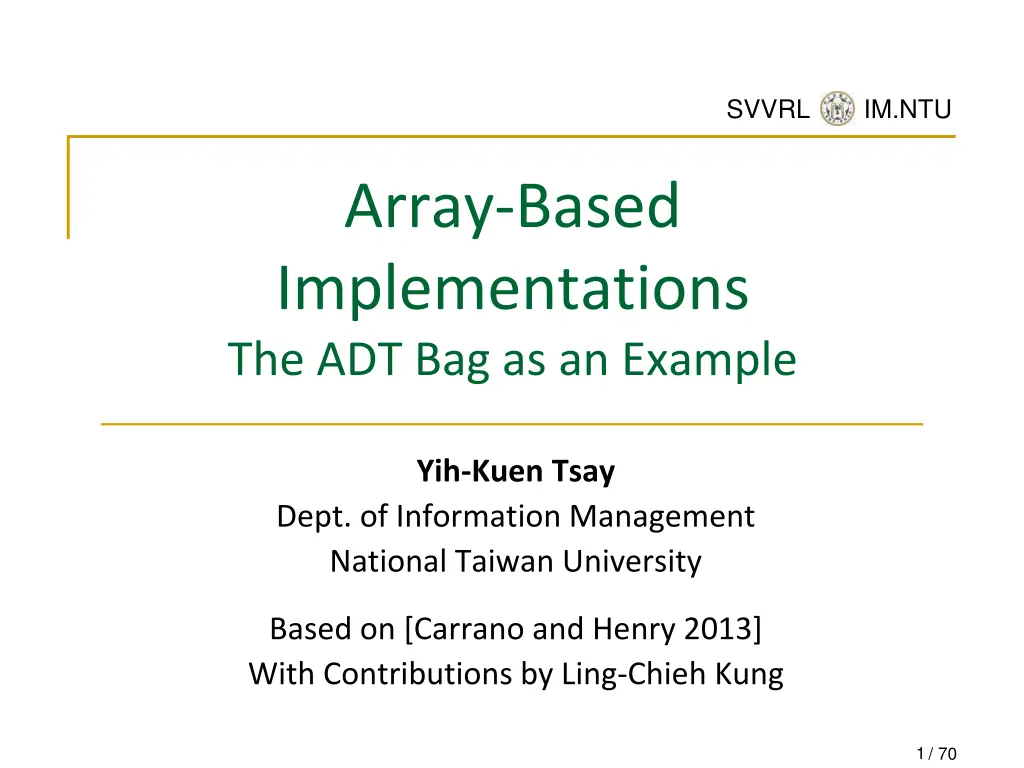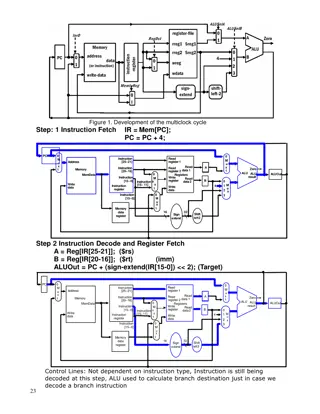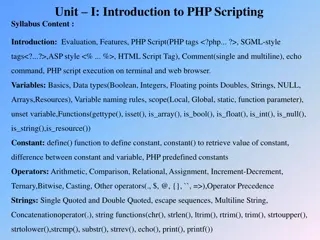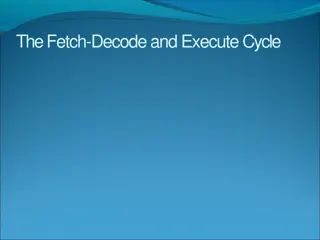
ADT Bag Array-Based Implementations at National Taiwan University
Learn about the Array-Based Implementations of the Abstract Data Type (ADT) Bag at National Taiwan University, focusing on implementing operations like adding, removing, and clearing items from a bag in C++ using recursion and dynamic memory allocation.
Download Presentation

Please find below an Image/Link to download the presentation.
The content on the website is provided AS IS for your information and personal use only. It may not be sold, licensed, or shared on other websites without obtaining consent from the author. If you encounter any issues during the download, it is possible that the publisher has removed the file from their server.
You are allowed to download the files provided on this website for personal or commercial use, subject to the condition that they are used lawfully. All files are the property of their respective owners.
The content on the website is provided AS IS for your information and personal use only. It may not be sold, licensed, or shared on other websites without obtaining consent from the author.
E N D
Presentation Transcript
SVVRL @ IM.NTU Array-Based Implementations The ADT Bag as an Example Yih-Kuen Tsay Dept. of Information Management National Taiwan University Based on [Carrano and Henry 2013] With Contributions by Ling-Chieh Kung 1 / 70
SVVRL @ IM.NTU Outline The ADT Bag (of Strings) Implementation with an Array Recursion and DMA The (Generic) ADT Bag Self-Defined Header Files The Standard Library <vector> Yih-Kuen Tsay DS 2016: Array-Based Implementations 2 / 70
SVVRL @ IM.NTU The ADT Bag We want to implement an ADT Bag of items whose types are ItemType: +getCurrentSize(): integer +isEmpty(): boolean +add(newEntry: ItemType): boolean // duplicates are allowed +remove(anEntry: ItemType): boolean // remove only one copy +clear(): void +getFrequencyOf(anEntry: ItemType): integer +contains(anEntry: ItemType): boolean +print(): void Specifications indicate what the operations do, not how they are implemented. Let s begin with a bag of C++ strings. Yih-Kuen Tsay DS 2016: Array-Based Implementations 3 / 70
SVVRL @ IM.NTU Implementing the ADT Bag (1/4) Implementing the ADT as a C++ class provides ways to enforce a wall: This prevents one from accessing the data without using the defined operations. Source: Figure 3-1 [Carrano and Henry 2015] Yih-Kuen Tsay DS 2016: Array-Based Implementations 4 / 70
SVVRL @ IM.NTU Implementing the ADT Bag (2/4) The abstract class BagInterfacedefines the behaviors of the ADT. In many cases, no member variable is needed for the abstract class. class BagInterface { public: virtual int getCurrentSize() const = 0; virtual bool isEmpty() const = 0; virtual bool add(const string& newEntry) = 0; virtual bool remove(const string& anEntry) = 0; virtual void clear() = 0; virtual int getFrequencyOf(const string& anEntry) const = 0; virtual bool contains(const string& anEntry) const = 0; virtual void print() const = 0; }; Yih-Kuen Tsay DS 2016: Array-Based Implementations 5 / 70
SVVRL @ IM.NTU Implementing the ADT Bag (3/4) class ArrayBag : public BagInterface { private: // ... public: ArrayBag(); int getCurrentSize() const; bool isEmpty() const; bool add(const string& newEntry); bool remove(const string& anEntry); void clear(); bool contains(const string& anEntry) const; int getFrequencyOf(const string& anEntry) const; void print() const; }; To implement the ADT, we write a (concrete) class to inherit BagInterface and implement all the operations. Yih-Kuen Tsay DS 2016: Array-Based Implementations 6 / 70
SVVRL @ IM.NTU Implementing the ADT Bag (4/4) Now it is time to choose a data structure. For the ADT Bag, we will try two different data structures: An array and a linked list. Let s use a fixed-size (static) array first. In a fixed-size array, each item occupies one entry of the array. These items are unsorted. A one-dimensional unsorted array will be used. Source: Figure 3-2 [Carrano and Henry 2015] Yih-Kuen Tsay DS 2016: Array-Based Implementations 7 / 70
SVVRL @ IM.NTU Outline The ADT Bag (of Strings) Implementation with an Array Recursion and DMA The (Generic) ADT Bag Self-Defined Header Files The Standard Library <vector> Yih-Kuen Tsay DS 2016: Array-Based Implementations 8 / 70
SVVRL @ IM.NTU Using a Fixed-Size Array class ArrayBag : public BagInterface { private: static const int DEFAULT_CAPACITY = 6; string items[DEFAULT_CAPACITY]; int itemCount; int maxItems; // may have something else... public: // those member functions... }; What else should we keep track of when we use a fixed-size array? The maximum size of the array. The number of items currently stored. We add member variable declarations to the private section. Yih-Kuen Tsay DS 2016: Array-Based Implementations 9 / 70
SVVRL @ IM.NTU Implementing Member Functions ArrayBag::ArrayBag() : itemCount(0), maxItems(DEFAULT_CAPACITY) {} int ArrayBag::getCurrentSize() const { return itemCount; } bool ArrayBag::isEmpty() const { return itemCount == 0; } void ArrayBag::print() const { for(int i = 0; i < itemCount; i++) cout << items[i] << " "; cout << endl; } Some member functions are pretty straightforward. Note that these should be constant member functions. How would you add a constructor to choose a maximum number of items? Yih-Kuen Tsay DS 2016: Array-Based Implementations 10 / 70
SVVRL @ IM.NTU The Member Function add() (1/2) For adding an item: If there is room, store the item somewhere in the array (where?) Return true if there is room, or false otherwise. Let s put it in the first empty cell. If the array has no hole, its index is exactly itemCount. Otherwise, we may need to search from the beginning. Source: Figure 3-3 [Carrano and Henry 2015]: After adding an item Yih-Kuen Tsay DS 2016: Array-Based Implementations 11 / 70
SVVRL @ IM.NTU The Member Function add() (2/2) As long as the array has no hole, adding an item is easy. When we remove an item, we need to maintain this property! bool ArrayBag::add(const string& newEntry) { bool hasRoomToAdd = (itemCount < maxItems); if(hasRoomToAdd) { items[itemCount] = newEntry; itemCount++; } return hasRoomToAdd; } Why using a constant reference? Why not just string newEntry? Yih-Kuen Tsay DS 2016: Array-Based Implementations 12 / 70
SVVRL @ IM.NTU Testing the Implementations Before we try to implement something more, test your existing member functions. Once you have your add() function, you may test the constructor, isEmpty(), getCurrentSize(), and print(). In fact, print()is to test add() and other member functions. int main() { ArrayBag bag; bag.add("aaa"); bag.print(); cout << bag.isEmpty(); cout << bag.getCurrentSize(); bag.add("bbb"); bag.print(); cout << bag.isEmpty(); cout << bag.getCurrentSize(); return 0; } Yih-Kuen Tsay DS 2016: Array-Based Implementations 13 / 70
SVVRL @ IM.NTU The Member Function remove() For removing a given item: Remove one copy if it exists in the array. Return true if the item exists, or false otherwise. Note that we need to determine whether a given item exists. This is exactly the function contains(). Moreover, we need to locate that item. We may enhance modularity (and make the development more efficient) by implementing a member function to be a building block. Yih-Kuen Tsay DS 2016: Array-Based Implementations 14 / 70
SVVRL @ IM.NTU The Member Function getIndexOf() Let s implement a member function getIndexOf(). getIndexOf(anEntry: ItemType): integer Given an item, return the index of its first copy in the array or 1 otherwise. Source: Figure 3-4 [Carrano and Henry 2015] Define things precisely: Returning an array index or a rank of an item? Yih-Kuen Tsay DS 2016: Array-Based Implementations 15 / 70
SVVRL @ IM.NTU The Member Function getIndexOf() int ArrayBag::getIndexOf(const string& target) const { bool found = false; int result = -1; int searchIndex = 0; while(!found && (searchIndex < itemCount)) { if(items[searchIndex] == target) { found = true; result = searchIndex; } else searchIndex++; } return result; } Yih-Kuen Tsay DS 2016: Array-Based Implementations 16 / 70
SVVRL @ IM.NTU Privatizing getIndexOf() The function getIndexOf()should be private! class ArrayBag : public BagInterface { private: static const int DEFAULT_CAPACITY = 6; string items[DEFAULT_CAPACITY]; int itemCount; int maxItems; int getIndexOf(const string& target) const; public: // those member functions... }; If it is public, clients will know some details of the private array. Data hiding (encapsulation, the wall ) would be damaged. As long as one thing is useless to clients, hide it! Yih-Kuen Tsay DS 2016: Array-Based Implementations 17 / 70
SVVRL @ IM.NTU The Member Function remove() remove(anEntry) { Search the array itemsfor anEntry if(anEntryis in the bag at items[index]) { Decrement the counter itemCount remove the item while ensuring no hole return true } else return false } With getIndexOf(), remove()can be easily implemented. How to remove the item while ensuring no hole? Yih-Kuen Tsay DS 2016: Array-Based Implementations 18 / 70
SVVRL @ IM.NTU Ensuring No Hole (Idea 1) Source: Figure 3-5 [Carrano and Henry 2015] Yih-Kuen Tsay DS 2016: Array-Based Implementations 19 / 70
SVVRL @ IM.NTU Ensuring No Hole (Idea 2) Source: Figure 3-6 [Carrano and Henry 2015] Yih-Kuen Tsay DS 2016: Array-Based Implementations 20 / 70
SVVRL @ IM.NTU Implementing remove() remove(anEntry) { Search the array itemsfor anEntry if(anEntryis in the bag at items[index]) { Decrement the counter itemCount remove the item while ensuring no hole return true } else return false } bool ArrayBag::remove(const string& anEntry) { int locatedIndex = getIndexOf(anEntry); bool canRemoveItem = (locatedIndex > -1); if(canRemoveItem) { itemCount--; items[locatedIndex] = items[itemCount]; } return canRemoveItem; } Yih-Kuen Tsay DS 2016: Array-Based Implementations 21 / 70
SVVRL @ IM.NTU Functions contains()and clear() The functions contains()is straightforward. bool ArrayBag::contains(const string& anEntry) const { return getIndexOf(anEntry) > -1; } How about clear()? Which one is better? void ArrayBag::clear() { while(!isEmpty()) remove(items[1]); } void ArrayBag::clear() { itemCount = 0; } Yih-Kuen Tsay DS 2016: Array-Based Implementations 22 / 70
SVVRL @ IM.NTU Member function getFrequencyOf() getFrequencyOf()returns the number of occurrences of a given item. int ArrayBag::getFrequencyOf(const string& anEntry) const { int frequency = 0; int curIndex = 0; while(curIndex < itemCount) { if(items[curIndex] == anEntry) frequency++; curIndex++; } return frequency; } Yih-Kuen Tsay DS 2016: Array-Based Implementations 23 / 70
SVVRL @ IM.NTU Remarks Before starting the implementation, always design the program first. Design the ADT. In particular, design the operations and behaviors. Write an abstract class to specify the operations. Write a concrete class to inherit the abstract class. Implement the class. For a specific function, pseudocodes are helpful. Test the implementation. Do not forget data hiding: If something is not useful for clients, hide it. E.g., do not let clients know whether you starts at items[0]or items[1]. Yih-Kuen Tsay DS 2016: Array-Based Implementations 24 / 70
SVVRL @ IM.NTU Outline The ADT Bag (of Strings) Implementation with an Array Recursion and DMA The (Generic) ADT Bag Self-Defined Header Files The Standard Library <vector> Yih-Kuen Tsay DS 2016: Array-Based Implementations 25 / 70
SVVRL @ IM.NTU Recursion Though not required, some functions can be implemented with recursion. In many cases, a task that needs to go through a data structure can be implemented with recursion. Let s look at two examples. Yih-Kuen Tsay DS 2016: Array-Based Implementations 26 / 70
SVVRL @ IM.NTU Using recursion for getIndexOf() int ArrayBag::getIndexOf(const string& target, int searchIndex) const { // search within items[searchIndex..(itemCount 1)] int result = -1; if(searchIndex < itemCount) { if(items[searchIndex] == target) result = searchIndex; else result = getIndexOf(target, searchIndex + 1); } return result; } Yih-Kuen Tsay DS 2016: Array-Based Implementations 27 / 70
SVVRL @ IM.NTU Using recursion for getFrequencyOf() int ArrayBag::getFrequencyOf(const string& anEntry) const { return countFrequency(anEntry, 0); } int ArrayBag::countFrequency(const string& target, int searchIndex) const { // count within items[searchIndex..(itemCount 1)] int frequency = 0; if (searchIndex < itemCount) { if (items[searchIndex] == target) frequency = 1 + countFrequency(target, searchIndex + 1); else frequency = countFrequency(target, searchIndex + 1); } return frequency; } Yih-Kuen Tsay DS 2016: Array-Based Implementations 28 / 70
SVVRL @ IM.NTU Using Recursion for the Two Functions The ways of applying recursion on getIndexOf()and getFrequencyOf()are different. We add a second parameter to getIndexOf(). We create a new function countFrequency()for getFrequencyOf(). The key factor determining the difference is their visibility. A private function is only used in the class. Its header can be modified. A public function is called by a client. Its header should remain unchanged. If we add searchIndexto the public function header, we reveal some information about the implementation. This violates data hiding. Yih-Kuen Tsay DS 2016: Array-Based Implementations 29 / 70
SVVRL @ IM.NTU Dynamically Adjusting the Array Size In the previous implementation, the array size is fixed. With dynamic memory allocation (DMA), we may make it changeable. E.g., let s double the array length when it is full. Yih-Kuen Tsay DS 2016: Array-Based Implementations 30 / 70
SVVRL @ IM.NTU Modifying the Class Definition class ArrayBag : public BagInterface { private: static const int DEFAULT_CAPACITY = 6; string* items; int itemCount; int maxItems; int getIndexOf(const string& target) const; public: ArrayBag(); ~ArrayBag(); // others are not changed }; To do so, first we change the class definition. itemsbecomes (purely) a pointer rather than a (static) array. When we implement DMA, we need a destructor. All others are unchanged. Yih-Kuen Tsay DS 2016: Array-Based Implementations 31 / 70
SVVRL @ IM.NTU The Constructor and Destructor ArrayBag::ArrayBag() : itemCount(0), maxItems(DEFAULT_CAPACITY) { items = new string[DEFAULT_CAPACITY]; } The constructor is modified to initialize items. It points to a dynamic array. ArrayBag::~ArrayBag() { delete [] items; } The destructor releases the dynamic array. Yih-Kuen Tsay DS 2016: Array-Based Implementations 32 / 70
SVVRL @ IM.NTU The Member Function add() add()is modified: bool ArrayBag::add(const string& newEntry) { bool hasRoomToAdd = (itemCount < maxItems); if(!hasRoomToAdd) { string* oldArray = items; items = new string[2 * maxItems]; for(int index = 0; index < maxItems; index++) items[index] = oldArray[index]; delete [] oldArray; maxItems = 2 * maxItems; } items[itemCount] = newEntry; itemCount++; return true; } When the array is full, double the array length. We use a local pointer oldArrayto point to the existing array. Do this before you use itemsto point to the new array. Otherwise, you will have memory leak. Then release the old space. Yih-Kuen Tsay DS 2016: Array-Based Implementations 33 / 70
SVVRL @ IM.NTU Should We Make the Array Dynamic? A dynamic array is of course useful. There is no need to worry about whether the array is full. Disadvantages: It can hurt efficiency: Every time when the array is full, we need to allocate a new space, copy and paste, and releasing an old space. It can waste spaces (as all static arrays do). Another way to prevent your bag from being full is to use a link-based implementation. Yih-Kuen Tsay DS 2016: Array-Based Implementations 34 / 70
SVVRL @ IM.NTU Outline The ADT Bag (of Strings) Implementation with an Array Recursion and DMA The (Generic) ADT Bag Self-Defined Header Files The Standard Library <vector> Yih-Kuen Tsay DS 2016: Array-Based Implementations 35 / 70
SVVRL @ IM.NTU Items in the ADT Bag class ArrayBag : public BagInterface { private: static const int DEFAULT_CAPACITY = 6; string items[DEFAULT_CAPACITY]; // ... public: // ... bool add(const string& newEntry); bool remove(const string& anEntry); // ... }; Our ADT Bag contains items. We implemented it as a bag of (C++) strings. What if we want to implement it as a bag of integers? Yih-Kuen Tsay DS 2016: Array-Based Implementations 36 / 70
SVVRL @ IM.NTU Templates (1/2) We hope that our implementation is general: In a bag, all items will be of a single type. For different bags, the item types can be different. In C++, templates make this possible. It can be applied on functions and classes. Note: the notion of a template is not unique to object- oriented programming. This is called generic programming. Yih-Kuen Tsay DS 2016: Array-Based Implementations 37 / 70
SVVRL @ IM.NTU Templates (2/2) C++ class templates allow one to pass a data- type argument when: Invoking a function defined with templates, or Creating an object whose class is defined with templates. In our example, objects of ArrayBagcan be created with the actual item type passed as an argument. ArrayBag<string> bagOfStrings; ArrayBag<int> bagOfIntegers; No need to write two implementations! Yih-Kuen Tsay DS 2016: Array-Based Implementations 38 / 70
SVVRL @ IM.NTU Template Declaration To declare a type parameter, use the keywords template and typename. template<typename T> class TheClassName { // T can be treated as a type inside the class definition block }; Some old codes write classinstead of typename. Both are fine. We then do this to all member functions: template<typename T> T TheClassName<T>::f(T t) { // t is a variable whose type is T }; template<typename T> void TheClassName<T>::f(int i) { // follow the rule even if T is not used }; Yih-Kuen Tsay DS 2016: Array-Based Implementations 39 / 70
SVVRL @ IM.NTU Template Invocation To instantiate an object, pass a type argument. int main() { TheClassName<int> a; TheClassName<double> b; TheClassName<AnotherClassName> c; }; The passed type will then replace all the Ts in the class definition. Yih-Kuen Tsay DS 2016: Array-Based Implementations 40 / 70
SVVRL @ IM.NTU An Example #include <iostream> using namespace std; Let s start from an example with no classes. When we invoke fwith f<double>, the function is void f(double t) { cout << t; } template<typename T> void f(T t) { cout << t; } int main() { f<double>(1.2); // 1.2 f<int>(1.2); // 1 When we invoke fwith f<int>, the function is void f(int t) { cout << t; } return 0; } That is why we see 1. Yih-Kuen Tsay DS 2016: Array-Based Implementations 41 / 70
SVVRL @ IM.NTU An Example with Two Type Parameters We may also have multiple type parameters. #include <iostream> using namespace std; template<typename A, typename B> void g(A a, B b) { cout << a + b << endl; } int main() { g<double, int>(1.2, 1); return 0; } Yih-Kuen Tsay DS 2016: Array-Based Implementations 42 / 70
SVVRL @ IM.NTU An Example with Classes #include <iostream> using namespace std; The syntax of applying templates to classes is very similar. template<typename T> class C { public: T f(); }; Add the declaration line to the class definition. Add the declaration line to all member function definitions. template<typename T> T C<T>::f() { return 1.2; } For each member function definition, specify the type parameter. int main() { C<int> c; cout << c.f() << endl; return 0; } Yih-Kuen Tsay DS 2016: Array-Based Implementations 43 / 70
SVVRL @ IM.NTU Applying Templates to BagInterface (1/2) Before we use a template, BagInterfacewas: class BagInterface { public: virtual int getCurrentSize() const = 0; virtual bool isEmpty() const = 0; virtual bool add(const string& newEntry) = 0; virtual bool remove(const string& anEntry) = 0; virtual void clear() = 0; virtual int getFrequencyOf(const string& anEntry) const = 0; virtual bool contains(const string& anEntry) const = 0; virtual void print() const = 0; }; Yih-Kuen Tsay DS 2016: Array-Based Implementations 44 / 70
SVVRL @ IM.NTU Applying Templates to BagInterface (2/2) After we use a template, BagInterfacebecomes: template<typename ItemType> // add this line class BagInterface { public: virtual int getCurrentSize() const = 0; virtual bool isEmpty() const = 0; virtual bool add(const ItemType& newEntry) = 0; // treat ItemType as a type virtual bool remove(const ItemType& anEntry) = 0; virtual void clear() = 0; virtual int getFrequencyOf(const ItemType& anEntry) const = 0; virtual bool contains(const ItemType& anEntry) const = 0; virtual void print() const = 0; }; Yih-Kuen Tsay DS 2016: Array-Based Implementations 45 / 70
SVVRL @ IM.NTU Applying Templates to ArrayBag (1/2) template<typename ItemType> class ArrayBag : public BagInterface<ItemType> { private: static const int DEFAULT_CAPACITY = 6; ItemType items[DEFAULT_CAPACITY]; int itemCount; int maxItems; int getIndexOf(const ItemType& target) const; public: // others that do not need ItemType bool add(const ItemType& newEntry); bool remove(const ItemType& anEntry); bool contains(const ItemType& anEntry) const; int getFrequencyOf(const ItemType& anEntry) const; }; Yih-Kuen Tsay DS 2016: Array-Based Implementations 46 / 70
SVVRL @ IM.NTU Applying Templates to ArrayBag (2/2) template<typename ItemType> // add this even if not used bool ArrayBag<ItemType>::isEmpty() const // add this even if not used { return itemCount == 0; } template<typename ItemType> bool ArrayBag<ItemType>::add(const ItemType& newEntry) { // ItemType can be used in the function definition bool hasRoomToAdd = (itemCount < maxItems); if(hasRoomToAdd) { items[itemCount] = newEntry; itemCount++; } return hasRoomToAdd; } Yih-Kuen Tsay DS 2016: Array-Based Implementations 47 / 70
SVVRL @ IM.NTU Using ArrayBag with Templates Now we can have bags for different types of items. int main() { ArrayBag<string> bagOfStrings; ArrayBag<int> bagOfIntegers; ArrayBag<MyClass> bagSpecial; bagOfStrings.add("here"); bagOfIntegers.add(123); MyClass mc; bagSpecial.add(mc); return 0; } Yih-Kuen Tsay DS 2016: Array-Based Implementations 48 / 70
SVVRL @ IM.NTU Final Remarks (1/2) An operation may need a special definition for a given type. template<typename ItemType> bool ArrayBag<ItemType>::add(const ItemType& newEntry) { bool hasRoomToAdd = (itemCount < maxItems); if(hasRoomToAdd) { items[itemCount] = newEntry; itemCount++; } return hasRoomToAdd; } What if ItemTypeis a class with dynamic memory allocation? Yih-Kuen Tsay DS 2016: Array-Based Implementations 49 / 70
SVVRL @ IM.NTU Final Remarks (2/2) What if ItemTypeis a class with undefined comparisons? template<typename ItemType> int ArrayBag<ItemType> ::getFrequencyOf(const ItemType& anEntry) const { int frequency = 0; int curIndex = 0; while(curIndex < itemCount) { if(items[curIndex] == anEntry) frequency++; curIndex++; } return frequency; } We need to (re)define operations for our classes. class RaNum { private: int num; int deno; public: // ... }; We need to do operator overloading. To be introduced in the next lecture. Yih-Kuen Tsay DS 2016: Array-Based Implementations 50 / 70






















